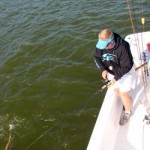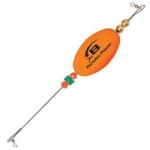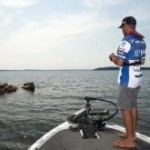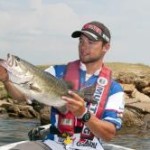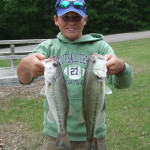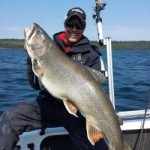
Huge Lake Trout caught on Lake Superior
For Lunker Lake Trout, You Don’t Need a Bigger Boat, you Need a Better Line
from The Fishing Wire
When you see the giant lake trout that Grant Sorensen and James Holst have been catching on Lake Superior, that line from Jaws might enter your mind – “We need a bigger boat.” But you don’t. Rather, you need a better line.
You need Sufix 832 Advanced Lead Core line.
“That stuff has truly changed the way we fish lake trout,” says Sorensen, a young-gun Rapala pro-staffer and personality on In-Depth Outdoors TV on Fox Sports North. “It’s just incredible how productive it is. It’s outfished downriggers for me, almost 15 to one.”
Sorensen began experimenting with Sufix 832 Advanced Lead Core two years ago with Holst, a fellow Rapala pro-staffer and In-Depth Outdoors TV’s host. Last fall, they caught several 30-plus-pound lake trout on Lake Superior while filming this In-Depth Outdoors TV show. In mid-August this year, Sorensen reeled in (and Holst netted) a fat, 44-inch Lake Superior laker. Holst documented that catch in this cell phone video.
“We’re doing things that nobody else that we’ve talked to is doing with any kind of regularity,” Holst says. “We’re fishing completely differently thanks to this 832 Advanced Leadcore. And we’re catching more fish because of it, including a ton of 20-plus pounders and a handful of 30-plus pounders.”
In addition to the lead core line, Holst and Sorensen’s lake trout set-up comprises multiple long rods, big spoons, planer boards and snap sinkers. It does not require cost-prohibitive equipment.
“You certainly don’t need a big, 30-foot boat with a cabin and downriggers everywhere and outriggers and this and that,” Sorensen says. “The past two years, the biggest fish we caught out of Lake Superior, we haven’t even had downriggers on the boat.”
Superior trends are “evolving away from the giant charter boats, monster ocean rods and reels and super heavy tackle,” Holst says. “People who don’t have – or don’t enjoy using – super-heavy equipment can use Sufix 832 Advanced Lead Core to catch trophy-size lake trout out of their walleye boats, on their walleye gear.
“Catching giants is now less intimidating, more affordable, more enjoyable,” Holst says.
Sorensen caught his 44-inch laker out of Holst’s 20-foot, 4-inch Skeeter MX 2025. But you don’t need a 20-plus-foot boat to get on this bite.
“I’ve been fishing the North Shore since I was five years old,” Sorensen says. “I used to fish out of my grandpa’s 17-foot Lund. … My friends have 17-, 18-foot boats. I fish out of those a lot. A 17- 18-foot boat is plenty for out there, as long as you’ve got a couple of rod holders and keep an eye on the weather before and during your trip.”
In the summer and fall, avoid east or south winds, Sorensen advises. In the spring, watch out for west winds. He relies on web-published weather information from The National Oceanic and Atmospheric Administration (NOAA) and the Coast Guard.
“They all put out good, reliable weather reports, so you can take a look at the winds and map your plan for the day,” Sorensen says.
Many good lake trout spots on Lake Superior are close to shore.
“You don’t need to run out 15, 20 miles,” Sorensen says. “You’ll be fine along the North Shore where we fish. It’s somewhat protected and safe – you can get back to land quick if need be.”
Anglers can enjoy much stable water and many calm days most of the summer and into early September. Late September and much of October is pretty stable too, but chillier. “You’ll definitely be able to fish in those conditions,” Sorensen says.
How (and how deep) to catch the giants
Sorensen and Holst’s giant lake trout program will look familiar to many anglers across the Upper Midwest.
“If you troll for suspended walleyes on big water, you already have the rods, reels, planer boards and rod holders,” Sorensen says. “You can just take that same approach on these huge Lake Superior lakers. A guy pretty good at catching walleyes can easily come up here and catch plenty of fish too.”
Sorensen and Holst troll in a gradual zig zag pattern, covering 10 to 80 feet of water. “That’s really hard to do with downriggers,” Sorensen notes. “That’s what makes Sufix 832 Advanced Lead Core so productive.” Lake Superior’s biggest lake trout seem to prefer the top 40 feet of the water column.
“With the 832 Advanced, we’re able to fish shallow lines, which is where we’re finding the biggest fish,” Holst explains.
In the last three years, of all Sorensen and Holsts’ catches heavier than 18 pounds have come shallower than 40 feet. And several of those weighed 25 to 35 pounds.
“And not just in one spot either,” Holst says. “We’ve fished Duluth, we’ve fished Two Harbors, we’ve fished Grand Portage, we’ve been all over the place. And every place we go using this technique, we’re just pounding big lake trout. And other people out there – fishing in more traditional ways – just don’t seem to catch the really big ones.”
Both Holst and Sorensen are convinced that traditional lake trout tactics scare away the bigger fish, which often suspend less than 60 feet deep.
“Downriggers, which run right below the boat, are spooking fish,” Holst says. “They’re moving fish out to the sides of the boat. And before those fish ever filter back in behind the boat, the lures are long gone.”
Baits presented on fluorocarbon leaders tied to Sufix 832 Advanced Lead Core, however, pull right through the strike zone without the need for a bulky downrigger.
“It gives you the depth to present your baits to suspending fish,” Holst explains. “It’s a lot thinner, more sensitive and it dives a lot deeper with the same amount of line out. You get 30 percent more dive depth than traditional lead core. And, its 70 percent stronger!”
44-inch behemoth
Although both Sorensen and Holst have caught numerous 20-plus-pound lake trout and several heftier than 30 pounds, the 44-incher Holst netted for Sorensen this August impressed even these two seasoned anglers.
“When we first saw the initial glimpse of the fish, we both just freaked out,” Sorensen recalls, noting that he fought it for 40 minutes, drifting about 1 ½ miles in the process. “Like, ‘Is it a surfboard coming up? Or a piano? Or a lake sturgeon? What is that thing?”
And although Sorensen works out with weights four times a week and is in great shape at 23 years old, he struggled to hold up the beast for this snapshot.
“It was just a truly amazing fish, one that most people probably wouldn’t even believe exists in Lake Superior,” Holst says.
Although the fish appeared big enough to challenge Minnesota’s lake trout state record of 43 pounds, 8 ounces, neither Sorensen nor Holst wanted to undergo a weighing and certification process that would certainly lead to the fish’s demise.
“It didn’t really cross our minds to keep her,” Sorensen says. “A fish of that size and caliber on Lake Superior is something pretty special. That water is so cold and the fish grow so slow, that fish could easily be 35, 40 years old. She was a beautiful, healthy fish, in her prime. So it didn’t take me very long to know that I wanted to let her go.”
After measuring the fish (but not weighing her; they did not have a scale onboard), Sorensen and Holst teamed to revive it boatside, one supporting it head, the other its tail.
“After two or three minutes, she darted down to the bottom and from that point on, she was just a memory,” Sorensen recalls. “It was just incredible.”

